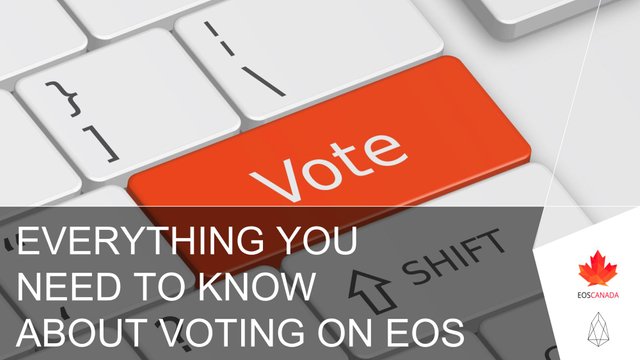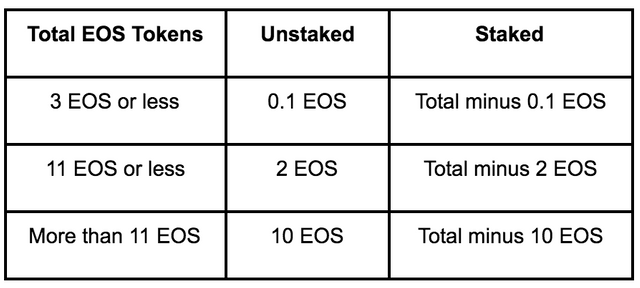Everything You Need To Know About Voting On EOS

Since the launch of the EOS Mainnet, EOS Canada has received many questions from the community. We wanted to provide a single place where users can find answers to understand voting on EOS. Feel free to send any questions you may have to our Telegram channel, and we will add to this list as needed.
What am I voting for?
The EOS network runs on the servers put in place by the elected Block Producers. The top 21 Block Producers (by amount of votes received), are the ones who actually create blocks on the EOS network. There will also be a list of Standby Producers who help to propagate transactions through the network, provide public endpoints for users, sites, and dApps to connect to, and who are waiting for their chance to produce blocks. There is no fixed amount of Standby Producers. However, only those who receive enough votes to reward them with 100 EOS or more per day, will be rewarded for this position. The Block Producers for whom we all vote are the custodians of the network. They should be teams which you trust to properly, and securely, operate the network on your behalf. This is a position that Block Producers do not take lightly, and you should do what you can to engage with your favourite Block Producers to ensure that they properly represent you.
How do I vote?
As of now, there are two ways that EOS Canada recommends. One is to use `cleos`, which is a command line tool put out by Block.one. The other tool is `eosc`, a command line tool created by the EOS Canada team. Below are some walk-throughs that were created by other groups. We are working on getting up video walk-throughs as well.
AlohaEOS | EOS Nation | Blockchain at Columbia
How do I find my EOS account name?
If you visit EOS Query, in the top right corner of the page you will be able to enter either your EOS public key, or your Ethereum public key. A dialogue box will then pop up, giving you your account name and your balance.
How do I change my vote?
There is no need to remove your vote in order to change it. All that is needed is to cast a new vote using a method in which you are comfortable voting. It is also worth noting that when you place your vote, you should include the entire list of Block Producers you wish to vote for within that single vote. Some users thought that each Block Producer required their own vote, however each new vote replaces previous votes.
What is the 15% threshold I keep reading about?
For all of the functions of the EOS blockchain to be unlocked, 150 million tokens need to be voted. This helps to ensure that the chain that is being voted on is seen by the community as the mainnet, and not just another chain that someone tried to start up. To follow along with the amount of votes already cast, please visit EOS Query.
Once the 150 million vote threshold has been reached, users will be able to start unstaking their tokens if they wanted to. It is expected that exchanges will only connect to the mainnet once this threshold has been reached. It should be noted that it will still take 72 hours after exchanges begin to unstake tokens for users to be able to withdraw from them.
How many votes do I get?
The amount of votes you have is equal to the amount of staked tokens that you have. So for example, if in your account you have 35 staked tokens, your vote will have a power of 35.
Within your account, you will see two different states for tokens to be in; staked and unstaked. Unstaked tokens are free to be moved around, transferred to another user, or used to make another account. Staked tokens are what allocate for your account the amount of Bandwidth and CPU you are guaranteed access to on the EOS network.
How many Block Producers can I vote for?
Every user can vote for up to 30 Block Producers. You can vote for any amount between 1 and 30, and you can also choose to not vote. If you vote for multiple Block Producers, each producer will receive the total voting power equal to the amount of staked tokens in your account. The power of your vote does not get split between the Block Producers you voted for. So if in your account you have 35 staked tokens and you vote for 30 Block Producers, each of them will receive 35 votes.
How often are votes counted?
Votes are tallied every 2 minutes and 6 seconds. There is no end to the voting process in EOS.
What is the amount of staked and unstaked tokens that I should have?

Why are some tokens unstaked or staked?
To begin, the EOS chain allocated a certain amount of unstaked and staked tokens to each account based on the amount of EOS tokens you held when the snapshot was taken of the ERC-20 tokens.
Every account that was created was also gifted the amount of RAM needed to create an account. This was due to the late addition of the need to purchase RAM for the creation of an account, which was introduced by Block.one one month before the launch of the mainnet.
The staked tokens in your account shows you the amount of CPU and Bandwidth your account is guaranteed access to. It also is the voting power your account has for each vote that it casts.
Why can't I transfer my tokens yet?
For tokens to be transferred, they first need to be in the 'unstaked' state. This process takes 72 hours to complete, after which you will be free to transfer your tokens to another account. Your original account created from the snapshot begins with some unstaked tokens, based on the table above.
How do I unstake my tokens?
Unstaking of tokens is a feature that will only be available once the 150 million vote threshold has been surpassed.
What else can I vote for?
Currently the only thing for which you can cast a vote is for Block Producers. It is expected within the next 3 to 6 months to have a referendum contract in place, which will allow users to cast votes on other things, such as Worker Proposals, or amendments to contracts like the Constitution.
How often should I vote?
You can cast your vote as often or as infrequently as you’d like. Once you have voted, your vote will remain in effect until you either remove it, or change it. However, your voting power will diminish after 1 week, going from full strength to no strength over the course of 2 years. To keep your vote at full strength, you would need to recast it once per week. If your vote begins to decay in strength, recasting will bring it back to full strength immediately.
Why should I re-cast my vote?
As stated above, rescasting your vote will keep it at full strength, giving your voice the power it deserves. This was done to encourage voters to stay up to date with the list of Block Producers, and discourage a “set it and forget it” approach. On other Delegated Proof of Stake blockchains, like SteemIt, we see Witnesses (their name for Block Producers) who have been inactive for a long time who are still receiving votes.
What is Proxy Voting?
A proxy is someone to whom you delegate the authority to vote on your behalf. Once a user has registered as a proxy, another user can delegate their voting power to that proxy. This effectively causes your votes to mirror that of the proxy you have named.
What are EOS Canada’s Endpoint connection details?
peering.mainnet.eoscanada.com:9876What is the correct chain ID that should be seen when voting?
Chain ID: aca376f206b8fc25a6ed44dbdc66547c36c6c33e3a119ffbeaef943642f0e906
Again another superb post guys, I am glad to see @eos-canada high the the ranks for BP’s to be selected.
Thank you for this!
Any idea when exchanges like Binance/Huobi will start to be able to accept our EOS?